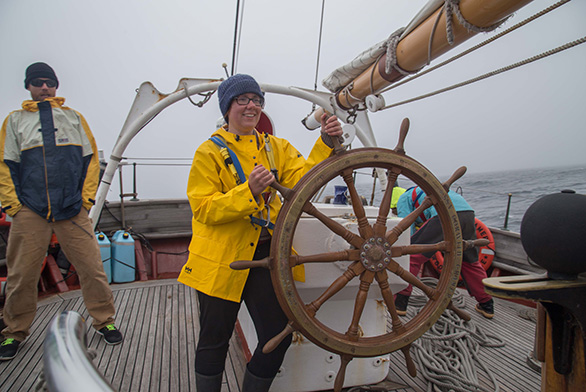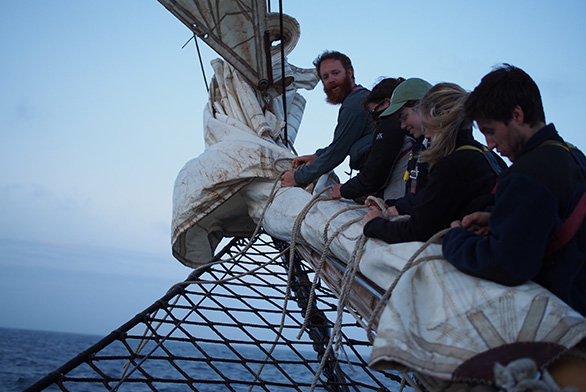The Fellowship Awakens
December 1, 2016 | By Tim Pratt

St. John’s College student Mary Christman was on watch when the Skellig Islands appeared through the haze off the coast of Ireland.
The sight of the rocky islands, made famous in “Star Wars: The Force Awakens,” was celebrated by Christman and her fellow sailors on board the SSV Corwith Cramer.
They had just spent nearly four weeks crossing the Atlantic Ocean.
“We all called ‘Land ho!’,” Christman says with a smile.
Christman was on board the 134-foot SSV Corwith Cramer as a result of a Global Pathways Fellowship.
Established in the fall of 2013, the Pathways Fellowships Program was created to enable St. John’s students to transition into graduate study or careers that call for special or prerequisite courses. Global Pathways Fellowships are available to Santa Fe campus students for summer study abroad; general Pathways Fellowships are available to Annapolis and Santa Fe students for summer study or attendance at professional conferences in the United States.
Christman applied for the Global Pathways Fellowship last school year as a junior on the college’s Santa Fe campus.
After an essay and an interview, Christman learned she was accepted into the SEA Semester study abroad program. She would be participating in a trans-Atlantic crossing. The goal was to conduct environmental research, collecting and analyzing data along the way.
The prospect of crossing the Atlantic was a bit nerve racking, Christman says, as she didn’t have much sailing experience.
“I went in knowing basically nothing,” she says.
As it turns out, not many of the other students on board—who hailed from colleges all over the country—had much experience either. The group of 15 students gathered in late May at Woods Hole, Massachusetts, where they spent a week in training. Joining them were 15 professional crew members, including a captain, engineer, scientists and others. They learned all they would need to know for their voyage, from boat safety and physics to details about the sails and scientific research.
On June 3, the vessel departed. The group spent the first night anchored in the nearby bay, then headed out into the Atlantic for the nearly 3,000-mile journey.

The trip was divided into three phases. In the first, the students “learned the ropes,” Christman says. They were told exactly what to do and how to do it.
But the students also had to deal with another factor, one the professionals on board could do little about: seasickness.
“After a few days of staying close to the rail everyone’s seasickness cleared and soon enough we were on to Phase Two,” Christman wrote in a report on the Fellowship.
The second phase consisted of shadowing the mates and scientists. Every watch, one of the students would be assigned to shadow and observe, to learn what decisions were being made and why, and to understand better the workings of the ship.
The goal was to prepare the students for the third and final phase: the junior watch officer/junior lab officer phase.
During the third phase, each student had to take over the watch from the mate. This meant they delegated tasks to shipmates, called the sails, deployed scientific equipment and communicated with the captain and chief scientist.
“They say we got our sea legs in that phase,” Christman says.
When they were standing watch, tasks included boat checks, lookout or being on the helm. Lab tasks included work with zooplankton, hourly readings of the ocean monitoring equipment or preparing and processing nets. The students also had to help with galley cleanup or dawn cleanup, depending on the time of their watch. And they had to be ready to handle sails whenever the need arose, staying alert for anything amiss.
Afternoons included an all-hands meeting where everyone would gather on deck to discuss the weather forecast, the ship’s position or other announcements. Students would then head to class and learn about sail theory, celestial navigation and marine science. They could also work on group research projects.
It was hard work, Christman says, yet they still had time for fun. Much of their free time was spent sleeping, but they also played music, sang, read, or hung out and enjoyed their time on the water. The crew members spotted dolphins and whales, and a variety of sea birds, Christman says. They even swam in the middle of the Atlantic. The weather was nice for most of the trip, Christman says, though they did occasionally deal with large swells.
Then, in late June, the crew spotted the first of the Skellig Islands. It appeared as a hazy triangle in the distance. “Star Wars”-themed celebrations were in order. The vessel then continued on to Cork, where the crew disembarked.
After arriving in Ireland, Christman spent a week with her aunt and uncle, who were visiting the Emerald Isle. They traveled around, hiked and enjoyed their time together.
Then Christman flew back to the United States.
Looking back, Christman says her time at St. John’s helped her with the scientific aspects of the trip.
“I knew how to ask questions and I wasn’t afraid to ask questions,” she says. “The scientists were really helpful.”
As she completes her final semesters at St. John’s this year in Annapolis, she is looking toward the future. She hopes to sail more, and is looking into a possible career in marine studies. Her trans-Atlantic journey has influenced her outlook on post-graduate life.
“It was definitely hard work, but it was one of the most rewarding experiences I’ve ever had,” she says.
The deadline for Global Pathways Fellowship applications is December 12. Advice about choosing and applying for a Pathways Fellowship can be obtained from Career Services staff at 505-984-6066 or .

